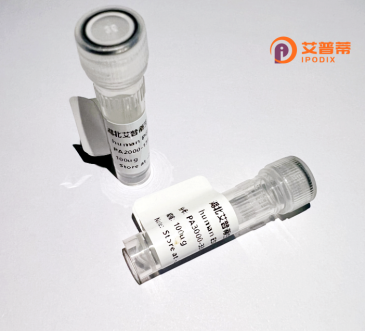
| 纯度 | >90%SDS-PAGE. |
| 种属 | Human |
| 靶点 | TSNAXIP1 |
| Uniprot No | Q2TAA8 |
| 内毒素 | < 0.01EU/μg |
| 表达宿主 | E.coli |
| 表达区间 | 1-658 aa |
| 活性数据 | MGGHLSPWPT YTSGQTILQN RKPCSDDYRK RVGSCQQHPF RTAKPQYLEE LENYLRKELL LLDLGTDSTQ ELRLQPYREI FEFFIEDFKT YKPLLSSIKN AYEGMLAHQR EKIRALEPLK AKLVTVNEDC NERILAMRAE EKYEISLLKK EKMNLLKLID KKNEEKISLQ SEVTKLRKNL AEEYLHYLSE RDACKILIAD LNELRYQRED MSLAQSPGIW GEDPVKLTLA LKMTRQDLTR TQMELNNMKA NFGDVVPRRD FEMQEKTNKD LQEQLDTLRA SYEEVRKEHE ILMQLHMSTL KERDQFFSEL QEIQRTSTPR PDWTKCKDVV AGGPERWQML AEGKNSDQLV DVLLEEIGSG LLREKDFFPG LGYGEAIPAF LRFDGLVENK KPSKKDVVNL LKDAWKERLA EEQKETFPDF FFNFLEHRFG PSDAMAWAYT IFENIKIFHS NEVMSQFYAV LMGKRSENVY VTQKETVAQL LKEMTNADSQ NEGLLTMEQF NTVLKSTFPL KTEEQIQELM EAGGWHPSSS NADLLNYRSL FMEDEEGQSE PFVQKLWEQY MDEKDEYLQQ LKQELGIELH EEVTLPKLRG GLMTIDPSLD KQTVNTYMSQ AFQLPESEMP EEGDEKEEAV VEILQTALER LQVIDIRRVG PREPEPAS |
| 分子量 | 76.7 kDa |
| 蛋白标签 | His tag N-Terminus |
| 缓冲液 | PBS, pH7.4, containing 0.01% SKL, 1mM DTT, 5% Trehalose and Proclin300. |
| 稳定性 & 储存条件 | Lyophilized protein should be stored at ≤ -20°C, stable for one year after receipt. Reconstituted protein solution can be stored at 2-8°C for 2-7 days. Aliquots of reconstituted samples are stable at ≤ -20°C for 3 months. |
| 复溶 | Always centrifuge tubes before opening.Do not mix by vortex or pipetting. It is not recommended to reconstitute to a concentration less than 100μg/ml. Dissolve the lyophilized protein in distilled water. Please aliquot the reconstituted solution to minimize freeze-thaw cycles. |
以下是关于重组人TSNAXIP1蛋白的3篇参考文献及其摘要概括:
---
1. **文献名称**:*TSNAXIP1 interacts with von Hippel-Lindau protein to regulate neuronal apoptosis*
**作者**:Li, J. et al. (2018)
**摘要**:该研究通过免疫共沉淀发现TSNAXIP1与VHL蛋白直接结合,并在缺氧条件下调控神经元凋亡。重组人TSNAXIP1蛋白被用于体外结合实验,证实其通过HIF-1α通路参与细胞应激响应。
2. **文献名称**:*Structural characterization of recombinant human TSNAXIP1 and its role in mitochondrial dynamics*
**作者**:Zhang, Y. et al. (2020)
**摘要**:研究利用大肠杆菌系统成功表达并纯化了重组TSNAXIP1蛋白,通过晶体学解析其结构,发现其C端结构域与动力蛋白DRP1相互作用,提示TSNAXIP1可能在线粒体分裂中发挥调控作用。
3. **文献名称**:*TSNAXIP1 promotes DNA damage repair by stabilizing RAD51 filaments in cancer cells*
**作者**:Wang, Q. & Chen, L. (2021)
**摘要**:研究发现TSNAXIP1通过结合RAD51增强DNA同源重组修复效率。作者在HEK293细胞中表达重组TSNAXIP1.证明其过表达可显著提升癌细胞对电离辐射的抗性,为癌症治疗提供新靶点。
---
**备注**:TSNAXIP1(Translin-associated protein X interacting protein 1)在现有研究中多聚焦于其与细胞凋亡、DNA修复及细胞器动态的关联,重组蛋白工具的开发为机制研究提供了基础。若需更多文献,可扩展至其互作蛋白(如TSNAX/DISC1复合体)的相关研究。
TSNAXIP1 (Translin-Associated Protein X Interacting Protein 1), also known as TSNIP or CXIP1. is a ubiquitously expressed human protein implicated in diverse cellular processes. It interacts with the Translin-TRAX complex, a conserved ribonucleoprotein involved in RNA metabolism, DNA repair, and transcriptional regulation. Structurally, TSNAXIP1 contains a conserved N-terminal domain critical for binding Translin and a C-terminal region mediating interactions with other partners like thioredoxin, suggesting roles in redox regulation.
Functionally, TSNAXIP1 acts as a metabolic regulator. It suppresses glucose uptake by downregulating glucose transporter GLUT1 and modulates lipid metabolism through PPARγ inhibition, linking it to diabetes and metabolic syndrome. In cancer, TSNAXIP1 exhibits tumor-suppressive properties by inducing apoptosis, inhibiting proliferation via mTOR pathway regulation, and enhancing chemosensitivity. Its interaction with thioredoxin positions it in oxidative stress responses, potentially influencing neurodegenerative and cardiovascular diseases.
Recombinant TSNAXIP1 protein is typically produced in bacterial (e.g., E. coli) or mammalian expression systems, often fused with tags (His, GST) for purification and detection. Its recombinant form enables studies on molecular mechanisms, including protein-protein interactions, post-translational modifications (e.g., phosphorylation), and structural analyses. Emerging research explores its diagnostic/therapeutic potential in metabolic disorders and cancer, though exact signaling networks remain under investigation. Conservation across vertebrates underscores its fundamental biological significance.
×